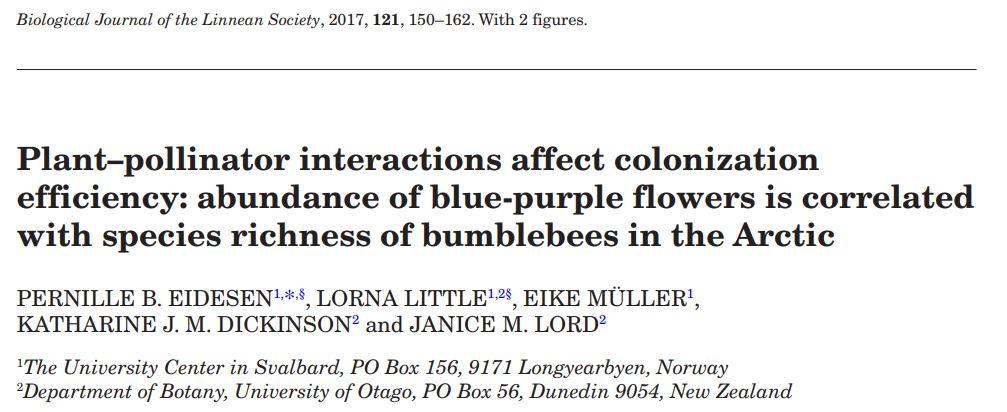Globally, most flowering plants reproduce sexually and are pollinated by insects or other animals rather than abiotic pollen vectors such as wind. Plant-pollinator interactions are usually mutualistic, where both sides benefit from the interaction; thus, the plant’s pollen is transferred to a receptor plant, while the pollinator retrieves food in the form of nectar or pollen. In colder regions, bowl-shaped flowers (solar furnaces) may also provide thermal refuges for basking insects, as they are often warmer than the surrounding ambient temperatures.
Successful pollination depends on pollinator visits and pollinator fidelity. Pollinator fidelity is a measure of how often a pollinator visits flowers of the same species or pollinator specialization. Arctic pollinators are few, less active, and dominated by generalists (Coulson, 2007; Elberling & Olesen, 1999; Tiusanen et al., 2016). Thus, the chance of successful pollination is overall low. Early-season pollinators, however, actively search for limited nectar resources on fewer flowering plants. With less species flowering, early-season generalists might therefore be more effective by increased same-species visits (Ison et al., 2018). It is also shown that more outcrossing species are found towards the ridges where the growing season starts earlier and last longer (Molau, 1993)
The flowers of the perennial purple saxifrage (Saxifraga oppositifolia) are attractive to specialist pollinators such as bumble bees, but even in systems where no bumble bees are present, this species show high levels of genetic diversity and clear signs of efficient out-crossing (Müller et al., 2012). Saxifraga oppositifolia is one of the first species flowering, and are probably efficiently pollinated by more generalist pollinators early in the season when it is the only flower present. Early flowers will however run the risk of frost events. However, Arctic plants are mainly perennial and not constrained by the need of immediate reproductive success. Thus, inter-annual variations in climate and pollination availability can be buffered. In addition, most arctic species can self -pollinate. In Saxifraga oppositifolia, the female parts of the flower (the stigma) mature first, allowing pollination with pollen from another open flower if insects are available. If cross-pollination does not occur within two to four days, the male flower parts (anthers) lengthen and curve inwards to facilitate self-pollination. However, self-pollination gives fewer and higher rate infertile seeds.
Abstract: Coevolution of efficient pollinators such as Bombus species (bumblebees) with the flowers they pollinate could make them spatially dependent on each other, thus affecting their distributions and abilities to colonize new areas. As Bombus species show a preference for blue-purple flowers, areas with a high diversity of Bombus species should correlate with a higher diversity of plants with blue-purple flowers. ………Read the article here
Coulson, S. J. (2007). Terrestrial and freshwater invertebrate fauna of the High Arctic archipelago of Svalbard. Zootaxa, 1448(1), 41-68.
Elberling, H., & Olesen, J. M. (1999). The structure of a high latitude plant‐flower visitor system: the dominance of flies. Ecography, 22(3), 314-323. https://doi.org/10.1111/j.1600-0587.1999.tb00507.x
Ison, J. L., Prescott, L. J., Nordstrom, S. W., Waananen, A., & Wagenius, S. (2018). Pollinator‐mediated mechanisms for increased reproductive success in early flowering plants. Oikos, 127(11), 1657-1669.
Molau, U. (1993). Relationships between Flowering Phenology and Life History Strategies in Tundra Plants. Arctic and Alpine Research, 25(4), 391-402. https://doi.org/10.1080/00040851.1993.12003025
Müller, E., Eidesen, P.B., Ehrich, D. and Alsos, I.G. (2012), Frequency of local, regional, and long-distance dispersal of diploid and tetraploid Saxifraga oppositifolia (Saxifragaceae) to Arctic glacier forelands. American Journal of Botany, 99: 459-471. https://doi.org/10.3732/ajb.1100363
Tiusanen, M., Hebert, P. D., Schmidt, N. M., & Roslin, T. (2016). One fly to rule them all-muscid flies are the key pollinators in the Arctic. Proc Biol Sci, 283(1839). https://doi.org/10.1098/rspb.2016.1271









